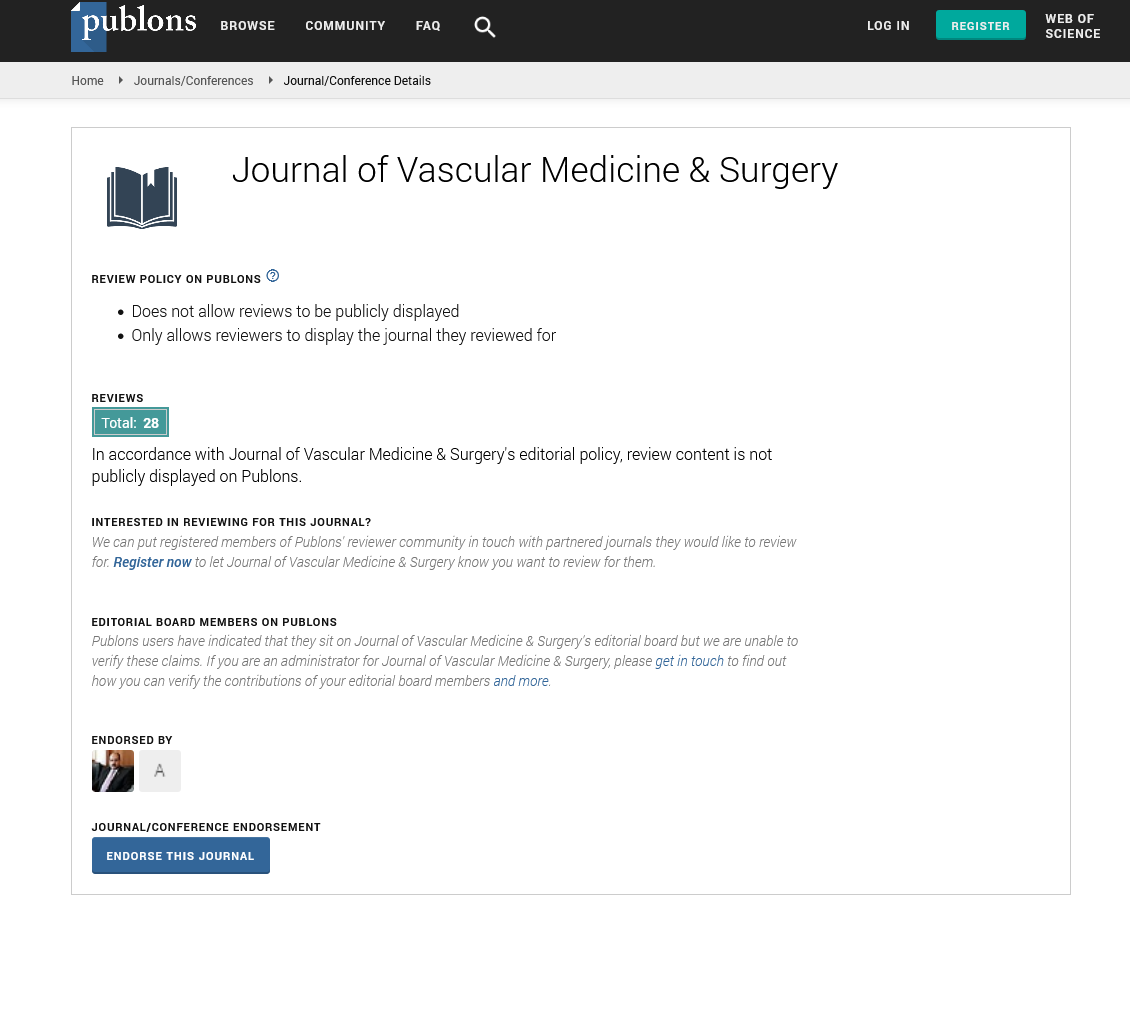Indexed In
- Open J Gate
- Academic Keys
- RefSeek
- Hamdard University
- EBSCO A-Z
- OCLC- WorldCat
- Publons
- Euro Pub
- Google Scholar
- SHERPA ROMEO
Useful Links
Share This Page
Journal Flyer

Open Access Journals
- Agri and Aquaculture
- Biochemistry
- Bioinformatics & Systems Biology
- Business & Management
- Chemistry
- Clinical Sciences
- Engineering
- Food & Nutrition
- General Science
- Genetics & Molecular Biology
- Immunology & Microbiology
- Medical Sciences
- Neuroscience & Psychology
- Nursing & Health Care
- Pharmaceutical Sciences
Commentary - (2025) Volume 13, Issue 4
Vascular Access: Navigating Complexity in an Aging Dialysis Population
Yan Xu*Received: 31-Mar-2025, Manuscript No. JVMS-25-28766; Editor assigned: 02-Apr-2025, Pre QC No. JVMS-25-28766 (PQ); Reviewed: 16-Apr-2025, QC No. JVMS-25-28766; Revised: 23-Apr-2025, Manuscript No. JVMS-25-28766 (R); Published: 30-Apr-2025, DOI: 10.35248/2329-6925.25.13.593
Description
The provision of optimal vascular access for hemodialysis patients remains one of the most challenging and consequential responsibilities of the vascular specialist. As the dialysis population continues to age and accumulate comorbidities, the traditional paradigms of access planning and management face increasing challenges. With approximately 468,000 hemodialysis patients in the United States alone, and median patient age exceeding 65 years, the imperative for thoughtful access strategies has never been greater.
The historical "Fistula First" initiative dramatically reshaped access practice patterns, driving a significant increase in Arteriovenous Fistula (AVF) prevalence from approximately 32% in 2003 to over 65% by 2020. While this shift aligned with the physiological advantages of autogenous access, including lower infection rates, superior longevity, and reduced maintenance requirements, the unintended consequences have become increasingly apparent. Primary failure rates for AVFs range from 20-60% in contemporary series, with even higher rates in elderly and diabetic patients. Furthermore, prolonged maturation times and the frequent need for assisted maturation procedures create substantial logistical challenges and catheter dependence.
These realities have prompted a recalibration toward a more nuanced "Patient First" approach that individualizes access planning based on patient-specific factors rather than rigid hierarchical preferences. This paradigm shift acknowledges that the ideal access for a 30-year-old with excellent vessels differs fundamentally from that for an 85-year-old with limited life expectancy and compromised vasculature. For some patients, particularly those with very poor prognosis or limited life expectancy, a tunneled catheter may represent the most appropriate initial access despite its inferior long-term characteristics.
Preoperative planning has evolved significantly with the widespread adoption of vessel mapping protocols. Duplex ultrasound assessment of arterial and venous anatomy has become standard practice, with criteria for minimal vessel diameter, absence of stenosis, and adequate depth guiding both access selection and configuration. More recently, advanced imaging modalities including magnetic resonance venography and CT venography have gained traction for complex cases with suspected central venous pathology or aberrant anatomy. These preoperative evaluations significantly improve primary success rates and reduce complications when interpreted within the broader clinical context.
Surgical techniques have similarly progressed, with increasing utilization of minimally invasive approaches including endoscopic vein harvest for transposition procedures. The emergence of percutaneous AVF creation using thermal or mechanical technologies represents a potentially transformative development, though long-term outcomes and optimal patient selection remain under investigation. Early results from the Novel Endovascular Access Trial (NEAT) and subsequent studies suggest promising technical success rates with acceptable patency for selected patients, though the generalizability of these findings to complex vascular patients remains uncertain.
Central venous stenosis represents a particularly challenging complication, affecting up to 40% of patients with previous catheter exposure. Management options including angioplasty, stenting, and surgical bypass provide temporary relief, but recurrence remains common. Prevention through judicious catheter placement and early fistula creation remains paramount, as established central stenosis significantly compromises future access options and may ultimately limit dialysis viability.
The growing prevalence of calcific arterial disease in the dialysis population creates additional technical challenges for arteriovenous access creation. Strategies including proximal arterial inflow, extensive preoperative decalcification, and adjunctive procedures such as radial artery deviation have expanded our ability to establish functional access in patients with heavily calcified vessels. Similarly, innovative configurations such as femoral vein transposition and axillary artery to axillary vein straight grafts provide alternatives when traditional options have been exhausted.
Catheter dependence remains excessively high despite these advances, with approximately 80% of patients initiating hemodialysis via catheter. Earlier nephrology referral, timely access planning, and coordinated multidisciplinary care are essential to address this persistent challenge. The implementation of dedicated access coordinators, standardized referral pathways, and integrated electronic health record systems can streamline the transition from predialysis care to functioning permanent access.
Emerging technologies including tissue-engineered vascular grafts, endovascular AVF creation platforms, and bioengineered vessels hold promise for expanding access options. Additionally, innovations in home hemodialysis systems requiring lower blood flow rates may reduce the technical demands on vascular access while improving patient quality of life and autonomy. One must balance technical capabilities with patient-centered care, recognizing that the ultimate goal extends beyond creating functional access to enhancing overall quality and duration of life for this vulnerable patient population.
Citation: Xu Y (2025). Vascular Access: Navigating Complexity in an Aging Dialysis Population. J Vasc Surg. 13:593.
Copyright: © 2025 Xu Y. This is an open access article distributed under the terms of the Creative Commons Attribution License, which permits unrestricted use, distribution, and reproduction in any medium, provided the original author and source are credited.

